So I decided it was time to give politics a rest. This isn't, after all, a political blog. It is a blog about odd, rambling things like wind tunnels and cocktails and cipher systems. And so, after the quiescent period following the election, as I slowly bring The Noodlebook back to life, I thought I'd get it going with a little science.
Dark energy, to be precise.
And not even dark energy as such because, let's face it, both my own small skill as an elucidator and the period of time I have available for this endeavor are dramatically inadequate for tackling so deep a mystery. Instead, in the classic talk-about-the-talking postmodernism of blogs, my attention turns to the investigations seeking to understand this phenomena rather than the phenomena itself.
I have, after all, always been much more of an experimentalist than a theoretician.
But to recap, dark energy is a postulated force that would explain some rather odd behavior of the universe. The oddity in question (for there are several oddities about our universe that require postulated things to explain them) is that the universe seems to be expanding at an ever increasing rate. Now that the universe is expanding is not at all odd. We've known about this since Edwin Hubble, a man brilliantly characterized as a "large mass of ego" by Bill Bryson, noticed that all the galaxies in the universe are expanding away from each other. Subsequently, a series of theories beginning with the "big bang" and moving on to modern inflationary cosmology have homed in on the idea of the universe originating at some sort of very small beginning (there are a few variations) and expanding outward from some sort of initial impulse (again, there are a few variations).
This is all fine and good and if you want some ideas about the how/why on that it won't surprise anyone that I now recommend Brian Greene's
The Fabric of the Cosmos. But this expansion should be slowing -- as the shared gravitational attraction of all the, well, stuff in the universe gathers together and pulls on itself. And for a few billion years, it appears that it did. But then a few billion years ago, the rate of expansion began accelerating again. There is no good reason for this, not with the rule that we've been playing by.
It is as if, to invoke a classic Feynmanism, we were watching a chess game, thought we'd got the rules and moves pretty much figured out, and then someone castled. Uh-oh, what the hell was that?
Since then, cosmologists, astrophysicists, particle physicists, and plain old ordinary physicists have all gotten in on the bandwagon to try and explain why. The lure of being the first to explain a new (or dramatically revised) physical force is a pretty big one!
Alright, enough of that back-explanation. I said that actually trying to
explain dark energy was beyond me. Oh, but it is different from
dark matter. I know. They could have come up with some more varied names. Like "The Smuckers Effect" or perhaps "The Universal Choo-Choo." Either one might have been better.
So this dark energy stuff, whatever it is, is suddenly pushing the universe apart faster and faster. Or not so suddenly. Or it remains constant or decreases as a quadratic function while gravity decreases as a cubic function. Sorry. Got distracted again. The point is, we have no idea what this force, this dark energy, is. We can only observe what it
does. And that makes it a wonderful place to study and understand the interplay between observation (experiment, if you like) and theory.
Science proceeds, in an idealized and perfect world, as a series of iterative steps. Someone observes a phenomena (say the increased rate of expansion of the universe). That person (and a few others) say "Damn, we didn't expect that!" Everyone then retires to their chalkboards and starts thinking of
theories to explain what is causing this phenomena. The theories will span a broad range. Some might involve zero point energy, others extra dimensions, still others giant turtles. As the theorists theorize, the experimenters begin to contemplate the next round of experiment or observation (I think of experiment as an active act -- where we
do something, such as at a particle collider -- while observation is a passive act where we take data on what the universe is already up to -- as with a telescope).
Theorists and experiments/observers are different. The former are the ones with the unkempt hair, the latter the ones with the dirty clothes and coffee addictions (particularly in astronomy).
Anyhow, while the theorists are using their imaginations and running the numbers, the experimenters/observers are doing their thing and building the next generation of machines. What proceeds then is something like a lottery. Or perhaps a reality TV show, though I doubt "Survivor: CERN" or "America's Next Top Scientists" or "Theorizing with the Stars" will take off anytime soon.
Any good theory brings a few ingredients to the table. It must offer an explanation for
why the phenomenon under consideration occurs. It ideally should offer a mechanism to explain
how it occurs. And it should provide some sort of mathematical formula that can fit the observed data to a high degree of accuracy. Lastly, that mathematical rigor should allow for some degree of prediction of as yet unobserved phenomena that can test the accuracy of the theory. This prediction might simply involve taking the measured predictions to a few orders of magnitude more precision. Or it might involve a wholly new physical manifestation. Either way, it provides some way of telling if the theory will have the winning number come lottery time -- the return of experimental results.
We go round and round like this. The results from each round of experiment feed the next round of theory. The predictions of a given round of theory guide the direction in which the experimenters/observers turn their searching. Rarely, however, are things so precisely beautiful as this, like turns in a board game. Usually, after a while, everything gets all out of synch and the experimental and theoretical processes get all overlapped.
But dark energy is new. It was accidental in a wonderful way, and the demands of further experiment have allowed for a long and fruitful phase of theoretical contemplation. And now the experimenalists are about to have their day. And by now I mean in about eight years, because that is how long it takes to get a space mission from budgetary contemplation to launch pad. And then a few more years of taking data.
Science is for the patient, these days.
This whole process of theory-experiment (or observation) is crucial to the scientific quest for understanding. It always galls me when people talk about how scientists don't actually know anything -- they just have a bunch of guesses. This points to a fundamental misunderstanding of what a
theory is. It isn't a guess. If it was, there might be some credence to the idea of giant turtles playing a role in dark energy. Rather, a theory is an educated attempt to explain a phenomena. It is a look by a very experienced observer at a set of behaviors, an assessment of what those behaviors might mean, and an attempt to predict what they might mean for the future.
We all form theories all the time. When we spot a car swerving erratically while driving at 2am, we say "Woah, look how that dude is driving. I betcha' he's drunk. Look out, he might miss that turn..." We observed phenomena, offered an explanation, and attempted a prediction. The depth of prediction can be tricky. If we only say "This driver will keep swerving around" it may not eliminate other possibilities such as looking for something he dropped, having an epileptic seizure, or making out with the passenger. But it is entirely possible that a drunk
will in fact make that next turn too. Or never intend to take it.
The scientific process is nothing different. It is not (and does not pretend to be) a fixed rulebook. It is an evolving set of understanding of the universe. Science is not a set series of answers as it is so often (and so wrongly) presented. Rather it is a
process, a pursuit of those answers.
And so when more accurate measurements gave rise to results that disagreed with the predictions inspired by Hubble's results, the result was not joy and frustration, but excitement at the opportunity to solve a new puzzle. An Asimov quote that those who have read email coming from my work address will recognize summarizes this mood better than anything:
The most exciting phrase in science, the one that heralds new discoveries, is not "Eureka!" but "That's funny..."
And now the prospect of dark energy is out there, proposing a grand enough prize and an exciting enough pursuit that seemingly everyone is getting into the game. Established scientists, cranks, those hawking ideas from the fringe, conspiracy theorists, random posters on the Internet: each one has some idea, spun slightly to reflect individual specialities and biases, for what might be at work.
The observational guys have been at it just as enthusiastically, constantly devising new approaches to reflect the latest ideas of the theorists and the latest technological developments in measurement apparatus. Dark energy isn't something we can test in a laboratory with a dark-energy-ometer or create with a steel cased apparatus connected to several thick cables. It acts, by all accounts, over vast distances and only manifests to a measurable degree when other forces (namely gravity) are at their most feeble. And so an earth-bound measurement (even if we knew what to look for) seems doomed to be swamped by noise.
This results in observatories. For various reasons, these would be observatories best sited in space, at the L2 point about a billion miles from earth, where it is dark and cold and not much gets in the way. The idea would be to observe, with great precision, the distances and recessional velocities of several thousand (or million) objects in the middle distance of the universe, the distances over which dark energy starts to manifest -- out to about twenty billion light years (117,580,000,000,000,000,000,000 miles).
A few approaches have shown up. The first involved hunting for something called Type 1A supernovae. These moderately rare explosions function through a well understood mechanism that has the handy feature of producing a reliably predictable brightness. The result is something called a "standard candle" -- an object of known intrinsic brightness which allows the estimation of its distance by comparing that source brightness with the observed brightness. That's good -- and Type 1A's are how this whole dark energy thing got started -- but it turns out it is not good enough.
Clouds of gas and dust can get in the way and it always is possible that we don't understand the Type 1A quite as well as we thought we did. So more recent approaches to understanding dark energy have tried to invoke several different techniques of measurement. Acoustic Baryonic Oscillations (I'm still trying to figure out what those are, but they sound really interesting), weak lensing, and a few others have all surfaced. The result is that any dark energy space mission that actually gets flown will end up as a fantastic multi-disciplinary observatory, quite different from the specialist that was originally envisioned.

The glory of all of these approaches, and of all of the missions that seek to imlement them, is that they will conduct their work through massive "wide and deep" surveys. Taking vast numbers of long exposure images across a large area of the sky, in other words. This is the advantage of a dedicated mission -- Hubble or the James Webb could do the same science, but are general purpose instruments contended over by the entirity of the vast astronomic (and astrophysic) community. But a dedicated mission, running a pre-planned scheme of observation, can produce the staggering amount of data that is necessary for the statistical analysis upon which dark energy studies must be based.
But this vast survey, while intended to specifically test a signle scientific concept, will also have enormous implications for the rest of the community. Currently, we stare through straws, looking across the vast night sky to find things that are interesting. Sometims we do so by chance, but more often we do so by looking at areas that we've already identified as interesting. The terabytes of data coming back from SNAP, DESTINY, ADEPT, JDEM, SPACE, Euclid, or whatever mission or missions end up flying will end up producing an astronomic and astrophysic legacy ready for the picking. A generation or more of astronomers and astrophysicists will mine this legacy to confirm and clarify their theories and hypotheses. And, here and there, they might discover something completely new, something entirely unexpected, something funny, and start the whole glorious process over again.
 Eclipse was a company that might have survived a few more years had the original timing worked out. They'd have launched towards the beginning of the boom and managed to get a few hundred products delivered before the carpet was so cruelly yanked out from under them. Odds are a lot of those little jets would have been repo'd, but that's another story. But I think that a longer life (and more sales) would only have lead to their death by other means -- the fundamental design, production, QA, QC, and customer services issues would have had enough time to come (further) to light and killed Eclipse off just as surely, all be it more slowly, than the economy tanking appears to have.
Eclipse was a company that might have survived a few more years had the original timing worked out. They'd have launched towards the beginning of the boom and managed to get a few hundred products delivered before the carpet was so cruelly yanked out from under them. Odds are a lot of those little jets would have been repo'd, but that's another story. But I think that a longer life (and more sales) would only have lead to their death by other means -- the fundamental design, production, QA, QC, and customer services issues would have had enough time to come (further) to light and killed Eclipse off just as surely, all be it more slowly, than the economy tanking appears to have.
 The glory of all of these approaches, and of all of the missions that seek to imlement them, is that they will conduct their work through massive "wide and deep" surveys. Taking vast numbers of long exposure images across a large area of the sky, in other words. This is the advantage of a dedicated mission -- Hubble or the James Webb could do the same science, but are general purpose instruments contended over by the entirity of the vast astronomic (and astrophysic) community. But a dedicated mission, running a pre-planned scheme of observation, can produce the staggering amount of data that is necessary for the statistical analysis upon which dark energy studies must be based.
The glory of all of these approaches, and of all of the missions that seek to imlement them, is that they will conduct their work through massive "wide and deep" surveys. Taking vast numbers of long exposure images across a large area of the sky, in other words. This is the advantage of a dedicated mission -- Hubble or the James Webb could do the same science, but are general purpose instruments contended over by the entirity of the vast astronomic (and astrophysic) community. But a dedicated mission, running a pre-planned scheme of observation, can produce the staggering amount of data that is necessary for the statistical analysis upon which dark energy studies must be based. That's pretty much all the fame and fortune that the most powerful (and expensive) single high energy physics experiment in history has received. I'm not going to go into the whole history or controversy surrounding the amazing new atom smasher (I love that phrase!) down by Geneva, LHC. But rather to relate the events at the Large Hadron Collider to some of my own experiences working at the Stanford Linear Accelerator Center -- SLAC. Everyone's favorite string theorist, Brian Greene, wrote a
That's pretty much all the fame and fortune that the most powerful (and expensive) single high energy physics experiment in history has received. I'm not going to go into the whole history or controversy surrounding the amazing new atom smasher (I love that phrase!) down by Geneva, LHC. But rather to relate the events at the Large Hadron Collider to some of my own experiences working at the Stanford Linear Accelerator Center -- SLAC. Everyone's favorite string theorist, Brian Greene, wrote a  Whereas at Amazon we may all have been acolytes following the word of The Bezos, at SLAC we were all acolytes performing arcane rituals of devotion and sacrifice to a multi-mile long vacuum filled tube and a collection of magnets, giant RF amplifiers called klystrons, and the associated cast of power supplies, measuring systems, controls, pumps, and all the rest. Electrons were hurled down the pipe, hammered along my enormous amounts of radio energy, looped through a heart-shaped half-circle and slammed into a corresponding beam of their antimatter counterparts, positrons. When these teensy particles are accelerated, thanks to some clever connections in the fundamental ground rules of the universe, they actually increase in mass/energy. So the resulting collision released an enormous amount of energy -- and in all kinds of interesting particles. A massive cryogenically cooled detector could track these heavyweight fragments and provide data on their behavior.
Whereas at Amazon we may all have been acolytes following the word of The Bezos, at SLAC we were all acolytes performing arcane rituals of devotion and sacrifice to a multi-mile long vacuum filled tube and a collection of magnets, giant RF amplifiers called klystrons, and the associated cast of power supplies, measuring systems, controls, pumps, and all the rest. Electrons were hurled down the pipe, hammered along my enormous amounts of radio energy, looped through a heart-shaped half-circle and slammed into a corresponding beam of their antimatter counterparts, positrons. When these teensy particles are accelerated, thanks to some clever connections in the fundamental ground rules of the universe, they actually increase in mass/energy. So the resulting collision released an enormous amount of energy -- and in all kinds of interesting particles. A massive cryogenically cooled detector could track these heavyweight fragments and provide data on their behavior. At SLAC that moment finally happened late one night when an operator off the late shift decided to experiment with some beam parameters in an unconventional way. For months the LEP collider (footnote -- the LHC is built in the tunnel originally constructed for LEP) had been providing a good deal more luminosity than us -- working in the same energy range but producing a LOT more collisions. Particle physics is, to a very great extent, a statistical science and it takes a good sample of behaviors to understand how you need to plot the graph. Our individual collisions produced cleaner data, but they were winning in a quantity-over-quality fight.
At SLAC that moment finally happened late one night when an operator off the late shift decided to experiment with some beam parameters in an unconventional way. For months the LEP collider (footnote -- the LHC is built in the tunnel originally constructed for LEP) had been providing a good deal more luminosity than us -- working in the same energy range but producing a LOT more collisions. Particle physics is, to a very great extent, a statistical science and it takes a good sample of behaviors to understand how you need to plot the graph. Our individual collisions produced cleaner data, but they were winning in a quantity-over-quality fight.

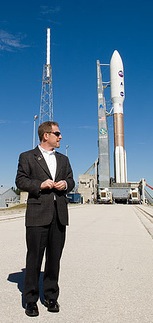
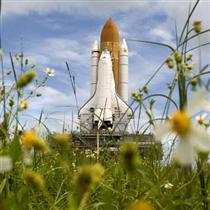 Launching from Kennedy, at 28 degrees North, provides a boost of 450 meters per second -- about 5% of our total rule-of-thumb velocity increment. For a hypothetical rocket I've been doodling out in the form of a Numbers spreadsheet, this works out to a payload (to low Earth orbit) launching from KSC allows the payload to increase from 7000kg (for a mythical zero-velocity launch site) to 8500kg! This happens for no increased launch vehicle mass, no increased cost, just a willingness to put up with a few hurricanes.
Launching from Kennedy, at 28 degrees North, provides a boost of 450 meters per second -- about 5% of our total rule-of-thumb velocity increment. For a hypothetical rocket I've been doodling out in the form of a Numbers spreadsheet, this works out to a payload (to low Earth orbit) launching from KSC allows the payload to increase from 7000kg (for a mythical zero-velocity launch site) to 8500kg! This happens for no increased launch vehicle mass, no increased cost, just a willingness to put up with a few hurricanes.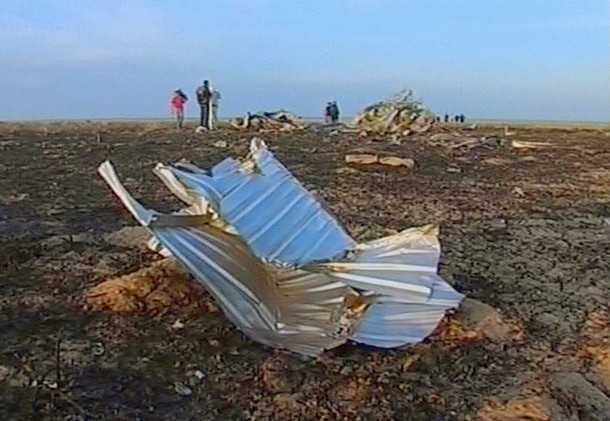 For starters, look at Russia. Devoid of a "space safe" site to the East (almost any Russian East coast launch site would have to fly over Japan), they are forced to launch from the West side of the nation, taking advantage of the vast reaches of emptiness that fill the middle part of Russia. This approach isn't without very serious drawbacks -- spent 1st stages from Russian Proton launchers litter the steppes of Kazakhstan. The toxic traces of the NTO/UDMH propellant that Proton uses have begun leaching into the groundwater supplies with, well, predictable results.
For starters, look at Russia. Devoid of a "space safe" site to the East (almost any Russian East coast launch site would have to fly over Japan), they are forced to launch from the West side of the nation, taking advantage of the vast reaches of emptiness that fill the middle part of Russia. This approach isn't without very serious drawbacks -- spent 1st stages from Russian Proton launchers litter the steppes of Kazakhstan. The toxic traces of the NTO/UDMH propellant that Proton uses have begun leaching into the groundwater supplies with, well, predictable results. The first thing that got these musings started was an article in Aviation Week that a
The first thing that got these musings started was an article in Aviation Week that a  Never the less, this illustrates one of the projected directions of modern air war. Un-crewed (we don't say "unmanned" any more) air vehicles have the wonderful ability to stay on scene for hours and hours and hours -- days even. A Reaper can loiter for NN hours, a Global Hawk for 40 to 48, and that latter figure after flying a 3,000nm round trip from home field to target area. This kind of sustained presence is invaluable in brining the areal perspective to the kind of fight going on in Iraq and Afghanistan. The traditional fast mover can offer little but responsive firepower -- heading in from a loitering point when called for by guys on the ground and depending on them for direction and guidance. Even maintaining that kind of ability -- a "cab rank" of close air support -- requires a couple of dozen aircraft in the field, tankers, and a rotating (and expensive) presence.
Never the less, this illustrates one of the projected directions of modern air war. Un-crewed (we don't say "unmanned" any more) air vehicles have the wonderful ability to stay on scene for hours and hours and hours -- days even. A Reaper can loiter for NN hours, a Global Hawk for 40 to 48, and that latter figure after flying a 3,000nm round trip from home field to target area. This kind of sustained presence is invaluable in brining the areal perspective to the kind of fight going on in Iraq and Afghanistan. The traditional fast mover can offer little but responsive firepower -- heading in from a loitering point when called for by guys on the ground and depending on them for direction and guidance. Even maintaining that kind of ability -- a "cab rank" of close air support -- requires a couple of dozen aircraft in the field, tankers, and a rotating (and expensive) presence. Only the guy-with-rifle can clear a stairwell without blowing up the building. Only the guy-with-rifle can rifle through the papers in a bomb-maker's hide looking for contacts. Only the guy-with-rifle can snap interconnected zip-ties across someone's wrists and send him back across the lines. Only the guy-with-rifle can man a roadblock or walk the streets on a dismounted patrol. Only the guy-with-rifle can use his wits and his skill in their purest form to go, see, and report with an intimacy with which no sensor package can compete. And, in the nicer side of the military, only the man-with-rifle can put down that gun and unload supplies or build schools or clear rubble or help the wounded or any of those humanitarian moments.
Only the guy-with-rifle can clear a stairwell without blowing up the building. Only the guy-with-rifle can rifle through the papers in a bomb-maker's hide looking for contacts. Only the guy-with-rifle can snap interconnected zip-ties across someone's wrists and send him back across the lines. Only the guy-with-rifle can man a roadblock or walk the streets on a dismounted patrol. Only the guy-with-rifle can use his wits and his skill in their purest form to go, see, and report with an intimacy with which no sensor package can compete. And, in the nicer side of the military, only the man-with-rifle can put down that gun and unload supplies or build schools or clear rubble or help the wounded or any of those humanitarian moments. Any given guy-with-rifle might now carry a personal radio and GPS receiver, a laser rangefinder, night vision gear, and a short range guided missile -- all gear inconceivable as personal equipment even twenty years ago. His rifle might have a laser spot projector for nighttime target marking, a flashlight, a grenade launcher, and a 4-power scope clamped and strapped to it. He may wear protective gear offering protection unheard of to previous generations of soldiers. But all of this goes to underscore not his budding obsolescence at the hands of impending robotic marvels but rather continued -- or even increased -- importance.
Any given guy-with-rifle might now carry a personal radio and GPS receiver, a laser rangefinder, night vision gear, and a short range guided missile -- all gear inconceivable as personal equipment even twenty years ago. His rifle might have a laser spot projector for nighttime target marking, a flashlight, a grenade launcher, and a 4-power scope clamped and strapped to it. He may wear protective gear offering protection unheard of to previous generations of soldiers. But all of this goes to underscore not his budding obsolescence at the hands of impending robotic marvels but rather continued -- or even increased -- importance. All of this makes one thing clear -- the rifleman is here to stay. The reasons for this emphasis shift are obvious -- increasing expectation of urban fighting, prevalance of counter-insurgency fighting, peacekeeping operations where forces work close to the civilian populations rather than in an open field battle -- are obvious and clear to anyone who watches the news. Tanks are retreating from their role as the unstoppable bohemouth's of the battlefield back to the role of supplying escort, protection, and covering fire for the infantry for which they were originally concieved. Air power is threatening to obsolete itself, metamorphosing (at least partially) from resplendant knights of the air into remote control spotters sitting in air-conditioned control vans thousands of miles from conflict.
All of this makes one thing clear -- the rifleman is here to stay. The reasons for this emphasis shift are obvious -- increasing expectation of urban fighting, prevalance of counter-insurgency fighting, peacekeeping operations where forces work close to the civilian populations rather than in an open field battle -- are obvious and clear to anyone who watches the news. Tanks are retreating from their role as the unstoppable bohemouth's of the battlefield back to the role of supplying escort, protection, and covering fire for the infantry for which they were originally concieved. Air power is threatening to obsolete itself, metamorphosing (at least partially) from resplendant knights of the air into remote control spotters sitting in air-conditioned control vans thousands of miles from conflict. What, in my roundabout way, I am trying to get to is this: I love sitting on a barstool, at a bar, watching the world go by (or participating in it -- barstool does not mandate or even imply passivity). The personal geography of the stool and the bartop are nearly perfect. A great height (if it is not too tall) for working on laptop. A great height for a book or magazine or some old fashioned pen-and-ink notepaper. There is enough space to spread out -- but not so much as to enable uncontrolled sprawling. A plate, a drink, and a book/laptop/magazine fit perfectly. This forces a tidy work habit and the selection of essential resources. The height of the surface also enables a pleasant multitasking -- the sharing of time between food and drink and whatever form of work (or recreation -- for a laptop computer or a book or some notepaper could imply either for me) is at hand.
What, in my roundabout way, I am trying to get to is this: I love sitting on a barstool, at a bar, watching the world go by (or participating in it -- barstool does not mandate or even imply passivity). The personal geography of the stool and the bartop are nearly perfect. A great height (if it is not too tall) for working on laptop. A great height for a book or magazine or some old fashioned pen-and-ink notepaper. There is enough space to spread out -- but not so much as to enable uncontrolled sprawling. A plate, a drink, and a book/laptop/magazine fit perfectly. This forces a tidy work habit and the selection of essential resources. The height of the surface also enables a pleasant multitasking -- the sharing of time between food and drink and whatever form of work (or recreation -- for a laptop computer or a book or some notepaper could imply either for me) is at hand. But almost all of this could happen at a table. The relationship between the tabletop and the body is not too different from that between the bartop and the body. But it is a significant difference. The bartop encourages a leaning, relaxed, elbows-on-the-table mood. The table is a rigorous place, both by arrangement and psychology, where posture must be maintained, children should be seen but not heard, and knife and fork must be used properly.
But almost all of this could happen at a table. The relationship between the tabletop and the body is not too different from that between the bartop and the body. But it is a significant difference. The bartop encourages a leaning, relaxed, elbows-on-the-table mood. The table is a rigorous place, both by arrangement and psychology, where posture must be maintained, children should be seen but not heard, and knife and fork must be used properly. And here, for the first time, we will also encounter the alcohol. From ancient Sumer on, people have found that properly treated fermented grains can produce a relaxed state, inducing of creativity, conversation, risk taking, and even, in the right situations, considerable productivity. In the classic pattern of the "if you mean whisky" fallacy, it can also produce excessively abrupt emails, poor proofreading, a tendency for summary resignations, misuse of Britney Spears crotch shots in PowerPoint presentations, and worst of all corporate Karaoke. But a little self restraint, here, and the benefits out weigh the risk of accidentally showing board members a photograph of Brit's underwear.
And here, for the first time, we will also encounter the alcohol. From ancient Sumer on, people have found that properly treated fermented grains can produce a relaxed state, inducing of creativity, conversation, risk taking, and even, in the right situations, considerable productivity. In the classic pattern of the "if you mean whisky" fallacy, it can also produce excessively abrupt emails, poor proofreading, a tendency for summary resignations, misuse of Britney Spears crotch shots in PowerPoint presentations, and worst of all corporate Karaoke. But a little self restraint, here, and the benefits out weigh the risk of accidentally showing board members a photograph of Brit's underwear. And then finally there has been the slow, bitter meltdown of Eclipse Aviation. At some point, I stopped believing and saw this as something that was bound to come. But not always. Five years ago, Vern's promises sounded good. Revolutionary, almost. A personal jet, a family flivver of the air. At long last Lewis Black and I would have our flying cars.
And then finally there has been the slow, bitter meltdown of Eclipse Aviation. At some point, I stopped believing and saw this as something that was bound to come. But not always. Five years ago, Vern's promises sounded good. Revolutionary, almost. A personal jet, a family flivver of the air. At long last Lewis Black and I would have our flying cars. And now back to Eclipse (and perhaps Space-X). Where is the flaw? Business plan? Technology? Both? Neither? I lean to both -- a technological product that was designed with enough giddy naivety as to be brittle and intolerant of setback and failure -- the failure of the FJ22 and the original avionics system -- and enough cut corners as to generate problems once in service. A business plan that depended on successes in volume production and demand generation that have, so far, eluded them. Eclipse isn't the first to fall to this error -- of assuming or expecting a demand that fails to appear. McDonnell (now Boeing) made the same sad error in planning the Delta IV rocket. Externally a beautiful vehicle, the Delta's approach to cost-effective launch pricing was based around generating a large demand and benefitting from economies of scale in production and launch. For various unfortunate reasons, this failed to appear.
And now back to Eclipse (and perhaps Space-X). Where is the flaw? Business plan? Technology? Both? Neither? I lean to both -- a technological product that was designed with enough giddy naivety as to be brittle and intolerant of setback and failure -- the failure of the FJ22 and the original avionics system -- and enough cut corners as to generate problems once in service. A business plan that depended on successes in volume production and demand generation that have, so far, eluded them. Eclipse isn't the first to fall to this error -- of assuming or expecting a demand that fails to appear. McDonnell (now Boeing) made the same sad error in planning the Delta IV rocket. Externally a beautiful vehicle, the Delta's approach to cost-effective launch pricing was based around generating a large demand and benefitting from economies of scale in production and launch. For various unfortunate reasons, this failed to appear.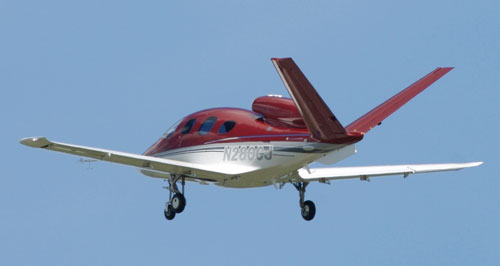 Cirrus is out there, with a successful line of piston singles and a sexy little jet on the drawing board. Cessna's managed to keep true to their word and move from strength to strength -- including the wonderful little Mustang that just might have contributed more than a little to Eclipse's troubles. Orbital is building a larger-yet rocket from their well understood and consolidated base. So the startups can continue and grow secure. The big guys can show some flexibility and innovation.
Cirrus is out there, with a successful line of piston singles and a sexy little jet on the drawing board. Cessna's managed to keep true to their word and move from strength to strength -- including the wonderful little Mustang that just might have contributed more than a little to Eclipse's troubles. Orbital is building a larger-yet rocket from their well understood and consolidated base. So the startups can continue and grow secure. The big guys can show some flexibility and innovation.